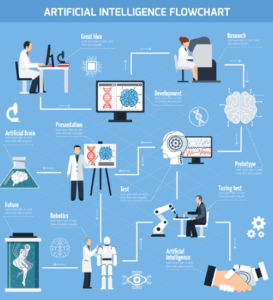Artificial intelligence (AI) is one of the fastest-growing technologies in the world and its impact is being felt across many sectors. As the use of AI training increases in businesses, it’s essential to ensure that employees are equipped with the necessary skills to work effectively with this technology. A well-trained workforce is an essential component of any organization seeking to maintain a competitive edge in the marketplace.
Understanding the importance of AI training and education

The growing role of AI in the workplace cannot be overstated. Given the remarkable advancements in AI technologies in recent years, it’s clear that its impact will only continue to grow.
Consequently, a workforce that is well-versed in AI technologies can be a huge benefit to a company. Well-trained employees can help organizations to drive efficiencies, create new revenue streams, and stay ahead of competitors.
Related Topic: Revolutionizing the Food Industry’s Business with Artificial Intelligence
The growing role of AI in the workplace
AI has already made significant inroads in sectors such as healthcare, transportation, finance, and manufacturing. AI-based technologies are increasingly being used to automate processes, reduce errors, and improve overall efficiency. It’s imperative that organizations provide training to ensure that employees are able to work with AI technologies safely and effectively. For instance, in the healthcare industry, AI technologies are being used to analyze vast amounts of patient data to help doctors make more informed decisions.
AI-powered tools can help doctors diagnose diseases, predict patient outcomes, and identify potential health risks. However, to use these tools effectively, healthcare professionals must be trained to understand how to interpret the data and use the tools safely.
In the manufacturing industry, AI technologies are being used to optimize supply chains, reduce waste, and improve product quality. AI-powered tools can help manufacturers predict equipment failures, optimize production schedules, and identify areas for improvement.
However, to use these tools effectively, employees must be trained to understand how to use the tools safely and how to interpret the data provided by the tools.
Benefits of a well-trained workforce on AI technologies
A well-trained workforce can have numerous benefits for an organization seeking to implement AI technologies. By investing in employee training and education, businesses can ensure that their employees feel confident in their abilities to work with AI tools. This confidence can help boost employee morale, increase efficiency, and ultimately result in a positive impact on the bottom line.
Furthermore, a well-trained workforce can help organizations to identify new opportunities for growth and innovation. When employees are trained to use AI technologies, they are better equipped to identify areas where these technologies can be applied to drive efficiencies, reduce costs, and improve overall performance.
Addressing skill gaps and future-proofing your organization
By providing employee training and education on AI technologies, organizations can help to bridge skill gaps and prepare their workforce for the future. Additionally, investing in AI training can allow businesses to future-proof their operations by ensuring that they are equipped to handle the challenges presented by new technologies.
For instance, as AI technologies continue to evolve, it’s likely that new tools and applications will emerge that require new skills and knowledge. By investing in employee training and education, organizations can ensure that their workforce is prepared to adapt to these changes and take advantage of new opportunities.
In conclusion, the importance of AI training and education cannot be overstated. A well-trained workforce can help organizations to drive efficiencies, create new revenue streams, and stay ahead of competitors.
By investing in employee training and education, businesses can ensure that their employees are equipped to work with AI technologies safely and effectively, and can future-proof their operations by preparing for the challenges and opportunities presented by new technologies.
Identifying the right AI training and education programs
Artificial Intelligence (AI) is rapidly transforming the business world, and organizations that want to stay ahead of the curve need to invest in AI training and education programs. However, before implementing such initiatives, it is important for organizations to identify the right programs that can best suit their specific needs.
Assessing your organization’s AI needs
Before investing in AI training and education, it’s important to assess your organization’s specific needs. This involves considering what tasks your organization currently performs that could be automated with AI technologies, and whether there are any gaps in your employees’ current skillsets that could be addressed through AI training.
For instance, if your organization relies heavily on customer service, you may want to consider AI training programs that focus on natural language processing (NLP) and chatbot development.
On the other hand, if your organization deals with large amounts of data, you may want to consider training your employees on AI-powered data analytics tools.
Exploring different types of AI training programs
There are a variety of AI training and education programs available to businesses. Online courses, webinars, and in-person training courses are just a few of the options available. Each program has its own strengths and weaknesses, and it’s important to choose the right type of training program for your organization.
Online courses and webinars are often more flexible and cost-effective, making them a good choice for organizations with limited budgets or employees who cannot travel for in-person training. In-person training courses, on the other hand, offer more hands-on experience and personalized attention from instructors.
Evaluating the Quality and Effectiveness of AI Courses
It’s important to assess the quality and effectiveness of any AI training courses that your organization is considering. This can be done by reading reviews, comparing pricing, and taking advantage of free trials or demos to ensure that the course will meet your needs before investing in it.
It’s also important to consider the credentials of the instructors and the reputation of the training provider. Look for training programs that are recognized by industry associations or have partnerships with reputable organizations. This can help ensure that the training you receive is of high quality and relevant to your organization’s needs.
In conclusion, investing in AI training and education programs can help organizations stay competitive and adapt to the rapidly changing business landscape.
By assessing your organization’s specific needs, exploring different types of training programs, and evaluating their quality and effectiveness, you can identify the right AI training and education programs to help your organization succeed.
Implementing AI training and education in your organization

Artificial Intelligence (AI) is rapidly becoming a vital part of many organizations, and it is essential that employees are adequately trained to work with these new technologies. Implementing AI training and education initiatives can seem daunting, but by taking a few key steps, organizations can ensure the success of their training programs.
Creating a comprehensive AI training plan
Developing a comprehensive training plan is essential to ensure that every employee receives the training they need. The training plan should be tailored to the specific needs of the organization and its employees. Consider factors such as the frequency of the training, the length of the training, and what specific skills the training should cover.
For example, if your organization is implementing an AI-powered chatbot to handle customer inquiries, employees who will be working with the chatbot should receive training on how to use it effectively. This training should cover not only how to use the chatbot but also how to troubleshoot any issues that may arise.
It is also important to consider the different learning styles of employees. Some employees may prefer hands-on training, while others may prefer online courses or classroom-style learning. By offering a variety of training options, organizations can ensure that every employee receives the training they need in a way that works for them.
Integrating AI education into existing training programs
AI education should be seen as a complementary component to existing training programs. Consider how AI education can be integrated into existing training programs to create a seamless learning experience for employees. For example, if your organization already offers training on customer service, consider adding a module on how AI can be used to improve customer service.
Integrating AI education into existing training programs not only saves time and resources but also ensures that employees see the connection between AI and their daily work. This can help to increase employee buy-in and engagement with the training program.
Encouraging employee engagement and participation
Ensure that employees understand the importance of AI training and education and encourage their engagement in the process. By fostering a culture of ongoing learning and development, organizations can help to ensure that their workforce remains innovative and forward-thinking.
One way to encourage employee engagement is to involve them in the development of the training program. Ask for feedback on what topics should be covered and how the training should be delivered. This not only shows employees that their input is valued but also ensures that the training program meets their needs.
Another way to encourage employee engagement is to offer incentives for completing the training program. For example, employees who complete the training could receive a certificate of completion or be entered into a drawing for a prize.
In conclusion, implementing AI training and education initiatives is essential for organizations that want to remain competitive in today’s rapidly evolving business landscape.
By creating a comprehensive training plan, integrating AI education into existing training programs, and encouraging employee engagement and participation, organizations can ensure the success of their training programs and the long-term success of their business.
Measuring the success of your AI training and education efforts
In today’s rapidly evolving technological landscape, it’s becoming increasingly important for organizations to keep their workforce up-to-date with the latest advancements in artificial intelligence (AI).
However, simply providing AI training and education initiatives is not enough. It’s equally important to measure the success of these initiatives over time to ensure that they are effective in achieving their intended goals.
Setting clear goals and benchmarks
Before embarking on any AI training program, it’s important to set clear goals and benchmarks to determine success. This will help ensure that each training initiative is aligned with the overall goals of the organization.
For example, if the goal of the organization is to improve customer service through the use of AI-powered chatbots, then the training program should focus on teaching employees how to build and maintain these chatbots.
Setting benchmarks can also help organizations track progress over time. For instance, if the goal is to have 80% of employees trained in AI technologies within the next year, then progress can be tracked on a regular basis to ensure that the organization is on track to meet this goal.
Tracking employee progress and performance
Tracking employee progress and performance can help identify areas where additional training may be needed. By regularly assessing employee performance, organizations can determine whether their training initiatives are effective in improving employee knowledge and skills in AI technologies.
One effective way to track employee progress is through the use of online learning management systems (LMS). These systems allow organizations to track employee engagement and progress in real time, providing valuable insights into the effectiveness of their training initiatives.
Gathering feedback and making improvements
Gathering feedback from employees can help to identify areas where improvements can be made. This feedback can be collected through surveys, focus groups, or one-on-one meetings with employees.
Once feedback has been collected, it’s important to use this information to make necessary changes and improvements to training and education initiatives. For example, if employees consistently report that certain training materials are confusing or difficult to understand, then these materials should be revised to make them more accessible and user-friendly.
By continuously gathering feedback and making improvements, organizations can ensure that their AI training initiatives are effective in improving employee knowledge and skills in AI technologies.
In conclusion, measuring the success of AI training and education initiatives is crucial for organizations that want to stay ahead in today’s rapidly evolving technological landscape. By setting clear goals and benchmarks, tracking employee progress and performance, and gathering feedback to make improvements, organizations can ensure that their workforce remains up-to-date with the latest AI technologies.
Conclusion
Providing employee training and education on AI technologies is essential for organizations seeking to maintain a competitive edge in the marketplace. By following these steps, organizations can identify the right AI training programs, implement effective training plans, and measure the success of their efforts over time.
A well-trained workforce can help organizations drive efficiencies, create new revenue streams, and stay ahead of competitors in an increasingly AI-driven world.
Are you interested in complete Automation of your business with AI? Get in touch with us for Free Online Consultation, and let’s get started!
Digital Pranav
Administrator

